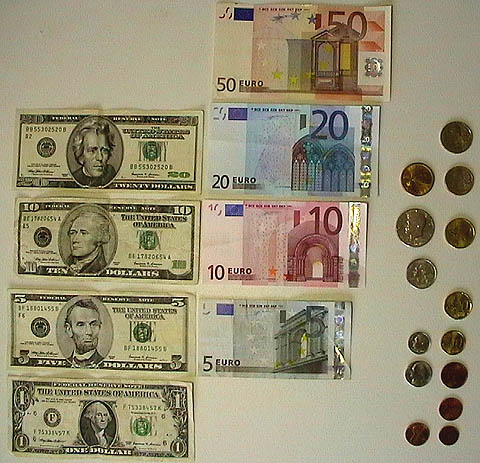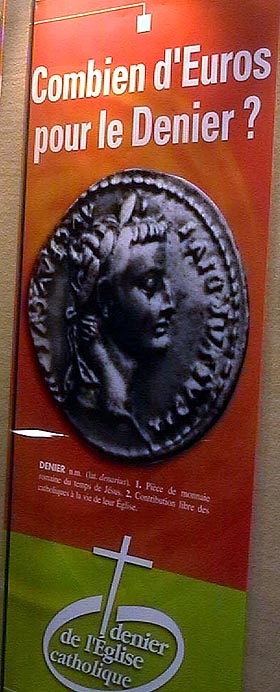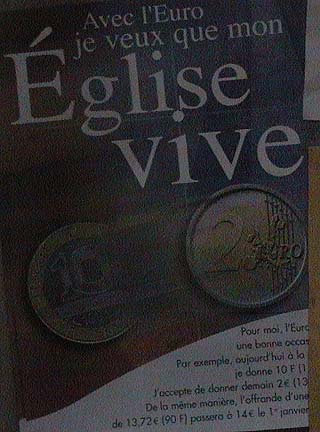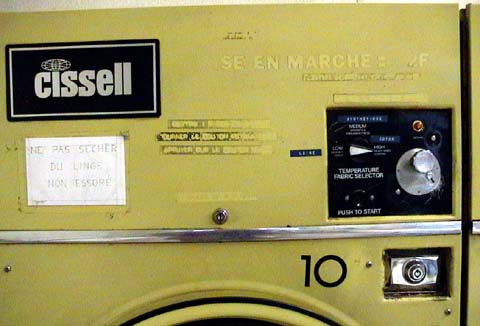Axtell / Giffords en France 2002
Thoughts on the Euro, May 26, 2002
We arrived in France two days after francs were removed from circulation.
Francs had been used since 1360 when King John minted his own coins and declared France to be
"frank" (i.e., free) of the English. We got to observe a currency's
infancy.
On Sunday, February 17, the period of double circulation (double
circulation) ended. Since January 1, 2002, when euros first became legal tender,
merchants had been accepting both francs and euros, but giving change only in
euros. When we arrived, on February 19, there was not a franc in sight. There
were lots of signs to help with the conversion and to assuage wary consumers
that they were not getting ripped off in the conversion. In particular, the
number 6.55957 was ubiquitous, making sure there was no mistake about the
franc-to-euro ratio.
In early March, Abbie found a 20 centime piece (about 3 U.S. cents) at a
playground. It's the only old money any of us has seen here.
Every cashier has had a little calculator with a special euro conversion
button. When you're quoted a price in euros, helpful merchants quickly calculate
the price in francs to help you compare. Of course, the price in francs is
meaningless to us. A euro is worth about 10% less than a dollar, so the close
euro-dollar relationship makes life easy for shopping Americans. The special
little calculators are in clearance sales now, so you may be getting them in
your Christmas stockings.
For our first weeks, all bills were new and crisp and all coins were shiny.
It felt as if we were in a brand new game of Monopoly. In late March, we saw a
torn 5 euro bill that had been taped. So, now we're in a well-used game of
Monopoly.

Above are the commonly-circulated bills from both the U.S. and the "Euro
Zone" along with all the currently-minted coins. You have to admit
that all U.S. bills look alike. There is no one-euro bill. There are 100, 200
and 500 euro bills not shown. The U.S. has 2, 50 and 100 dollar bills that
are used very little. The U.S. also has, technically in circulation, 500, 1000,
5000, and 10,000 dollar bills. These bills were last printed in 1946, last
distributed by the Treasury Department in 1969, and were not included in the
1996 redesign of the bills.
The euro bills are technological--if not artistic--marvels. They have enough
anti-counterfeiting features that merchants are confident that there are no
counterfeit bills, it seems. No one has hesitated when we've used one of the 50-euro
bills we get from the automatic tellers. The bills include several aids for the
visually impaired--something the U.S. ignores (except for bigger printing of the
numbers on the reverse on the new bills). The bills increase in size as they
increase in value, like many other world currencies. They also have raised areas
so you can distinguish them by feel. The 10 euro bill is the same width as the
U.S. bills. The 200 euro bill is about the same length as U.S. bills, but I
don't have one to show you.
The pictures on the bills are artistic creations of generic European
architectural things. They don't favor any country in particular. Although they
have no historical significance, they are fun to examine. U.S. bills have a
mixture of memorable and forgettable dead men.
 The
coins are a little more fun. Each country gets to design the reverse for their
own country. The obverses (shown at left) are all the same. It's like the state
quarter series that began in the U.S. in 1999. Coincidentally, euro coins were
first minted and dated 1999 in anticipation of the demand, even though they
weren't legal tender until 2002.
The
coins are a little more fun. Each country gets to design the reverse for their
own country. The obverses (shown at left) are all the same. It's like the state
quarter series that began in the U.S. in 1999. Coincidentally, euro coins were
first minted and dated 1999 in anticipation of the demand, even though they
weren't legal tender until 2002.
In many places, you see posters of the different coins. They seem to be as
much to accustom people to the new coins as they are to assure people that some
of the mysterious, less common designs (Luxembourg, for instance) are real
money.
We see very few of the other countries' coins. Saint-Etienne is isolated
geographically and commercially. That is, people from elsewhere don't come here
and spend cash. On March 8, in Paris, we got many euro coins from other
countries in change. Back in Saint-Etienne, in May now, we see a German and
Spanish euro
coin occasionally. The slow infiltration of euro coins from other countries
reminds us that we're in a very isolated area.
All eight euro coins are in everyday use. In contrast, only 4 US coins are used
and many people carry no one-cent coins. Instead, in the US, they leave the
one-cent pieces in
"take-a-penny, leave-a-penny" jars by cash registers. Even though the
euro cent is as close-to-worthless as the US cent, there are no take-a-centime,
leave-a-centime jars here. Actually, I did see one cashier at a Lidl (a
German-based discount supermarket) with a pile of spare centimes on the counter,
but then I never saw it again.
As an American, I've had trouble distinguishing 8 different coins in my
pocket. It shouldn't be hard to do. There's a variety of sizes, colors, and edge
designs to help. I simply never had to develop that sort of discrimination in my
formative years.
I used the term "centime" for a euro cent because it's the
common term now here. Sure, a centime is a hundredth of a franc, while a
"cent" is hundredth of a euro, but that creates a problem in French.
"Cent" means "one hundred", so deux cents sounds
confusingly like 200 rather than 0€02. I don't know what term was used during
the 7-week period of double circulation, but "centime" is a common
term for a euro cent in France now.
It's common to put the euro symbol where the decimal point (or decimal comma
in France) would go. I like that style because that's how people read currency
amounts. They'll say "5 euros 12" for 5.12. You, too, can use the euro
symbol on your computer. Just go to the "insert" menu and click on
"symbol". Alternatively, you can hold down the "Alt" key and
press 0128 on the numeric keypad.
The U.S. has a 25-cent piece, while the Europeans chose a 20-cent piece. I
don't know the reasoning, but I'll point out that the U.S. had a 20-cent piece
which is still legal tender. It had the shortest production for circulation of
any coin minted in US history, just 2 years in 1875-76.
Europe has a 2 cent piece. Of course, the U.S. did (and technically still does) have a 2-cent piece. It was coined 1864-1873 and,
as everyone knows, was the first coin to
have the motto, "In God We Trust".
I've heard no nicknames for any of these coins, yet. That's fine with this
easily-confused foreigner. Coin nicknames can nickel-and-dime you to death.
The equivalent of a dollar store was the 10 franc store. There are three in
Saint-Etienne. "Monsieur 10F" had a sign indicating that
everything in the store was 1€52. Another store offered everything for 1€50.
The third store I saw only from a distance and it still had "10F" in
huge characters. In late April, "Monsieur 10F" changed its name to
"C'est deux euros".
We've heard only a couple of reactions from genuine French people (which may
not be representative). Charlotte asked one local and his reaction was the
characteristic dismissal shrug and, "They didn't ask us." That's true.
The decision to join the Euro Zone was made by the French government. If the Assemblé
Nationale had said no, there would have been a national referendum.
The attitude may also reflect a mixed feeling about the franc, which lost
99.95% of its value through 17 devaluations during the 20th century. The French
may have also been less hesitant to undertake a currency switch because they had
a similar experience within a lifetime. In 1958 President Charles de Gaulle
created "new francs" and retired the "old francs". The new
francs were worth 100 old francs. That wasn't a devaluation, but rather an
effort to reduce all the extra zeroes in prices caused by decades of
hyperinflation.
The euro switch created some interesting worries. The Catholic Church is
particularly concerned with the free-will offering, called le denier, the
same name as an old roman coin. A common donation when the plate was passed was
a 10-franc coin. That coin looked a lot like a 1-euro coin, with a
silver-colored center and golden rim, but was worth 52% more than one euro.


The poster on the left says:
DENIER n.m.(1at. dernarias) 1. Pièce de monnaie romaine du temps de Jésus.
2. Contribution libre des catholiques à la vie de leur Église.
The poster on the right is more specific, explicitly suggesting that "Monsieur
10F" become "C'est deux euros". The picture on the
right was taken May 20 in Le Puy. It had probably been up since before January
and had two flyers covering part of it now.

This dryer (photographed May 4) tells the story of coping with a change in
currency. You can see the shadow of payment instructions from the days of the
franc. MISE EN MARCHE = 2F means putting in work costs 2 francs. You can
see a sheet metal screw in the coin slot now. Most coin-op laundries now have a
central pay station. You put in 30 centimes and press the "10" button
for this dryer. It's a more efficient and less trouble-prone system (that will
also let the company raise prices more easily). This seems to be a case where
the challenge of the new currency lead to a better solution. We found one
laundry that doesn't use a central pay station and modified all machines to use
euros. We also found one out-of-business laundry with the prices in francs still
posted in the window. It's possible that the expense of conversion was too much.
The white sign on the above dryer is still valid even after the conversion. It
says, "Ne pas secher du linge non ésoré" = No drying of
laundry not spun.
Overall, the change seems to be a great success. Europe now has a stable
currency that simplifies trade. The euro encourages trade with Europe by
removing one source of uncertainty. Meanwhile, the dollar lost a share of world
dominance when the Argentine economy collapsed in late February and is no longer
dollar based. It will be interesting to see if the U.S. loses some trade and
economic dominance with the advent of this convenient, multi-national currency.
Some details:
The 12 countries in the "Euro Zone" are: Belgium, Germany, Greece, Spain, France, Ireland, Italy, Luxembourg, The Netherlands, Austria, Portugal, Finland.
Some early information refers to 11 countries because Greece joined in 2001.
Great Britain is the most notable holdout, but most people expect them to join.
Switzerland never has been a part of the European Economic Union or any form of
cooperation. Consequently, Switzerland still has their own francs.
Here's the schedule for the changeover:
- 1er janvier 2002 : Les pièces et les billets en euros sont mis en circulation.
- 17 février 2002 à minuit : Retrait des francs.
- 28 février 2002 : fin du cours légal de toutes les monnaies nationales des pays de la zone euro.
- 31 mars 2002 : fin de l'échange des billets des monnaies nationales (hors franc) des pays de la zone euro, contre des euros, dans les succursales de la Banque de France.
- 30 juin 2002 : fin de l'échange des francs contre des euros dans les banques et à La Poste.
Links:
Some Afterthoughts:
Resorts in Cuba now accept euros as well as dollars, according to the NY
Times of June 2, 2002. This will, in some small way, increase the demand for
euros while decreasing the demand for dollars, thus strengthening the euro
against the dollar. I think we'll hedge and convert enough dollars now to make
it through July.
A July 2, 2002 N.Y. Times article describes how statisticians are tracking
the distribution of the Euro coins of the different countries. One hypothesis is
that they may spread in the same pattern as would a virus in an epidemic. Unlike
the U.S. state quarters, the Euro coins start in their own countries and spread
by hand-to-hand contact in arms-length transactions.
The U.S. mint now offers an overpriced 2002 U.S. mint set along with the 12
one-euro coins.
At the end of the trimester, I traded with my French teacher a Sacagawea
golden dollar and a Roosevelt dime for for about 8 francs in various
denominations. It would have been a headache to try to exchange that small sum
for euros and I was delighted to get some souvenir francs. Roosevelt is
memorialized here with le Square Franklin Roosevelt for coming to
France's aid in World War II. I brought ten golden dollars to France intending
to offer them as interesting and unusual thank-you gifts. I quickly discovered
that the French think Americans think about money way too much. Nine of the
dollars never left my suitcase.
Articles in the New York Times on August 7 and 10, 2002 tell of a man who
fished the coins out of the Trevi Fountain in Rome most nights since 1968. The
story came to light because the new euros (without the iron that the old lira
coins had) couldn't be retrieved with a magnet. When he started climbing into
the fountain to get the euro coins, he drew too much attention to himself.
-Dan Axtell
http://www.danaxtell.com/france
Back to: Notes from Saint-Etienne

 The
coins are a little more fun. Each country gets to design the reverse for their
own country. The obverses (shown at left) are all the same. It's like the state
quarter series that began in the U.S. in 1999. Coincidentally, euro coins were
first minted and dated 1999 in anticipation of the demand, even though they
weren't legal tender until 2002.
The
coins are a little more fun. Each country gets to design the reverse for their
own country. The obverses (shown at left) are all the same. It's like the state
quarter series that began in the U.S. in 1999. Coincidentally, euro coins were
first minted and dated 1999 in anticipation of the demand, even though they
weren't legal tender until 2002.

